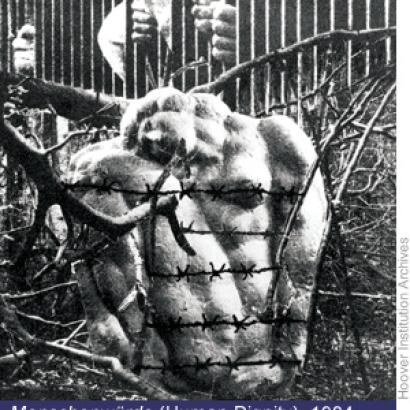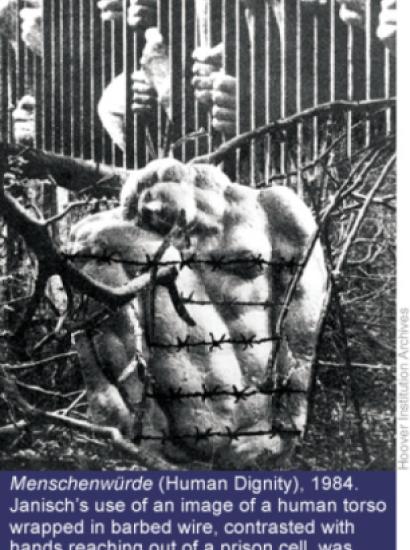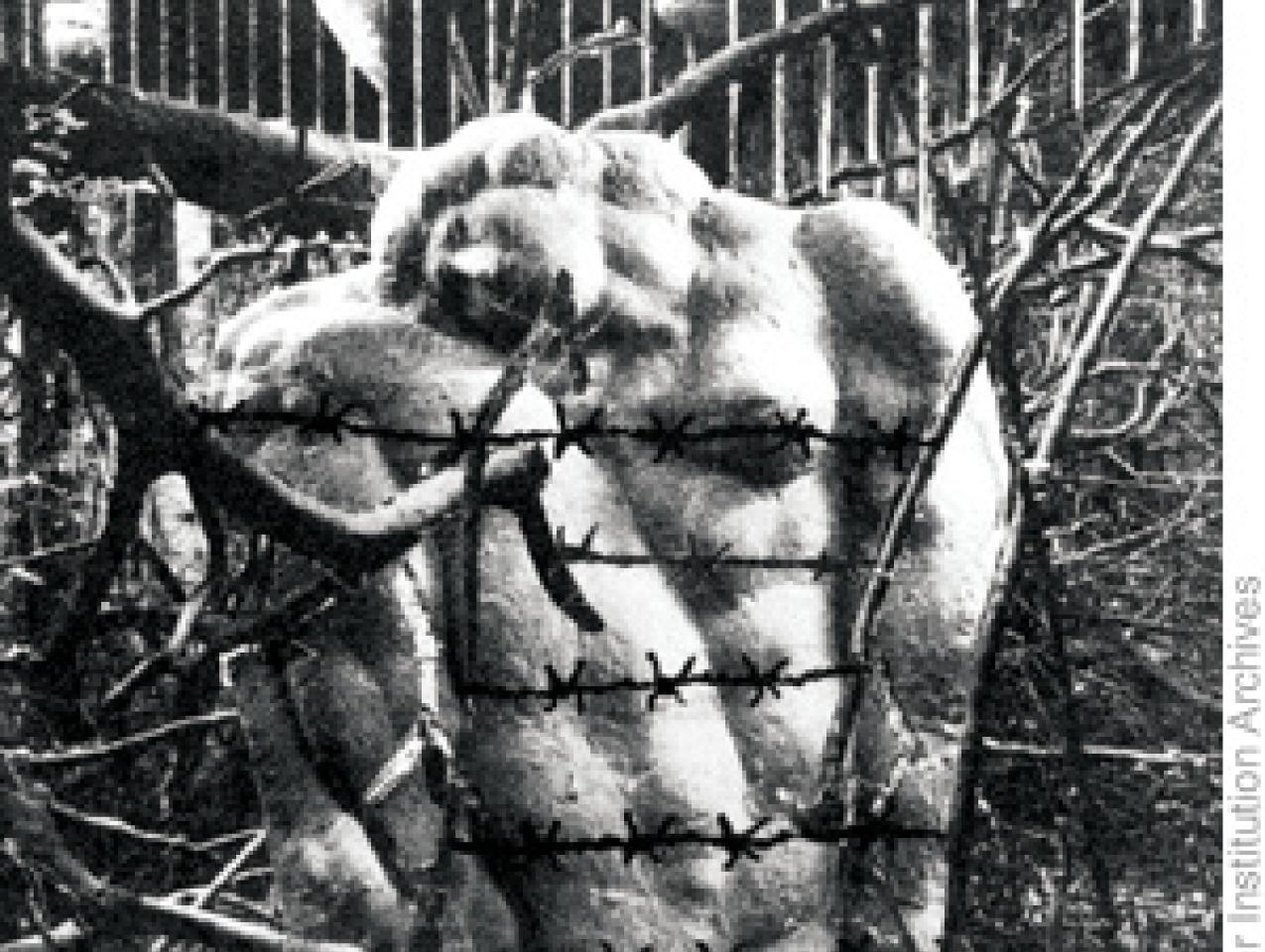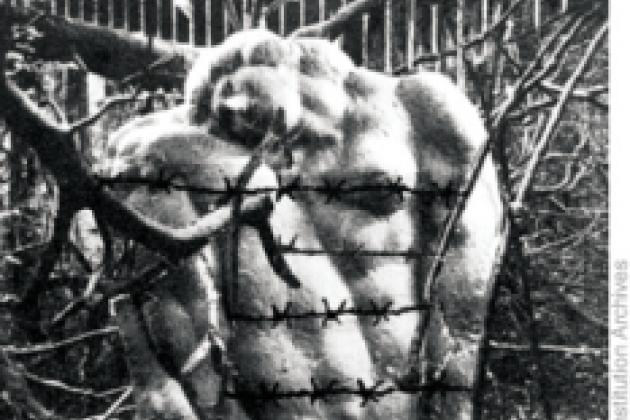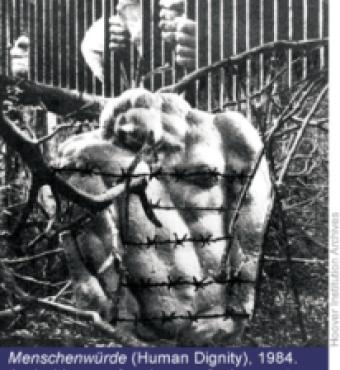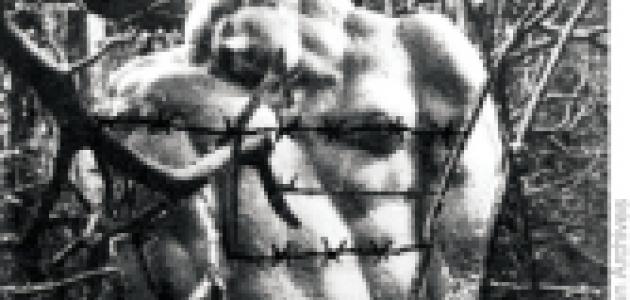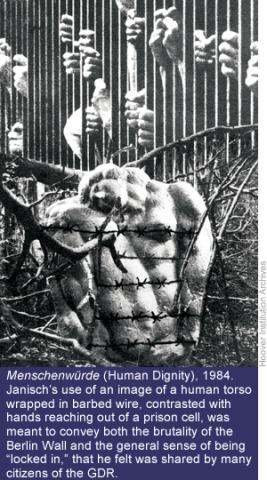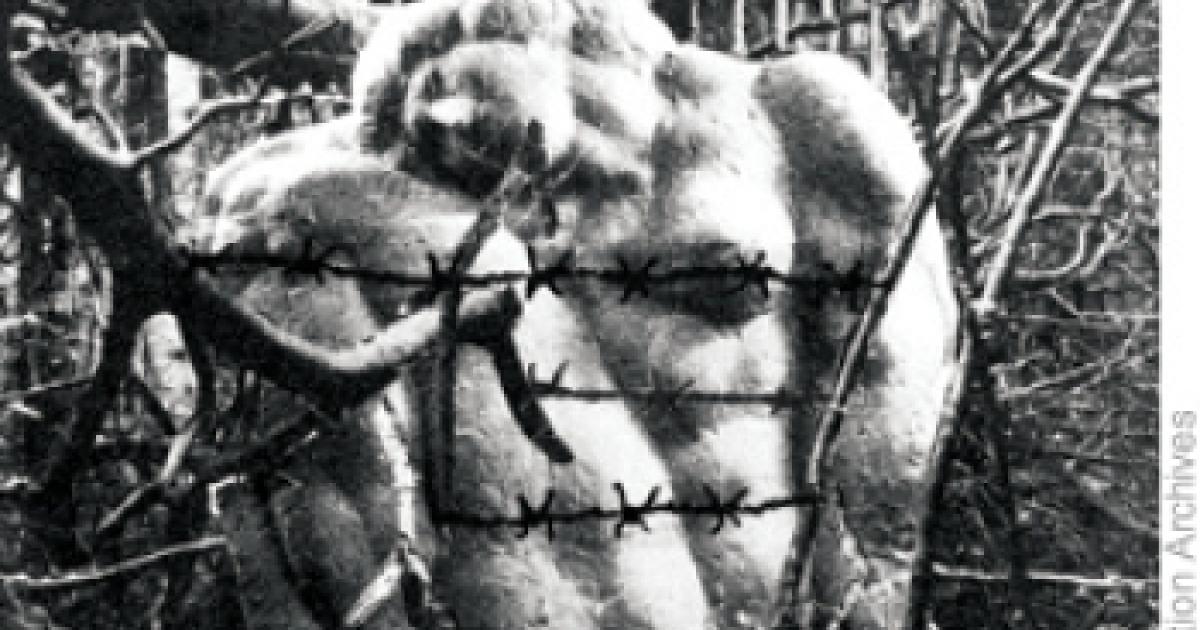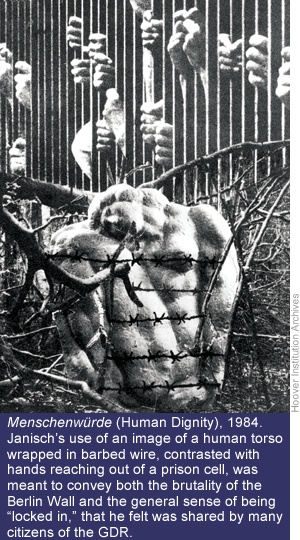
On a late winter day in 1987, graphic artist and peace activist Wolfgang Janisch stood nervously outside the embassy of the Soviet Union in East Berlin. For several years he had participated in a movement, based in the Protestant churches of East Germany and identified under the slogan “Swords into Plowshares,” that sought the removal from East German soil of short- and mid-range ballistic missiles placed there by Warsaw Pact forces. Janisch’s contributions to this movement were his numerous photocollage posters, which juxtaposed photographs and text in a manner that was edgy and humorous and conveyed urgent warnings of the dangers posed by nuclear war.
Although the East German government portrayed itself as the guardian of peace (routinely mouthing platitudes such as “Peace must be armed!”), it did not take kindly to the activities of groups that it had not officially sanctioned. Because Janisch had exhibited his posters in churches and other venues throughout East Germany, he had endured numerous instances of harassment and spying and even some attempts on his life. Yet by early 1987 there were signs of hope throughout Eastern Europe as would-be reformers expectantly followed the actions of Soviet premier Mikhail Gorbachev, who, under the banners of glasnost (“openness”) and perestroika (“restructuring”), introduced reforms in the Soviet Union that would have been unthinkable just a few short years before.
Thus with a sense of expectancy, Janisch ventured forth on his seemingly quixotic trip to the Soviet embassy, an imposing structure on the famed Unter den Linden, a few short blocks from where that boulevard abruptly ended at the barbed wire and concrete wall that sealed off the Brandenburg Gate from West Berlin. He had hoped not only to gain entrance to the embassy but also to leave several of his posters with embassy staff, hoping that they would forward them to Moscow and then to Gorbachev himself! One poster depicted a well-known photograph of American and Soviet soldiers greeting each other as their forces joined at the Elbe River during the closing days of World War II, with a caption beneath that read “Liberate Us Once Again!”
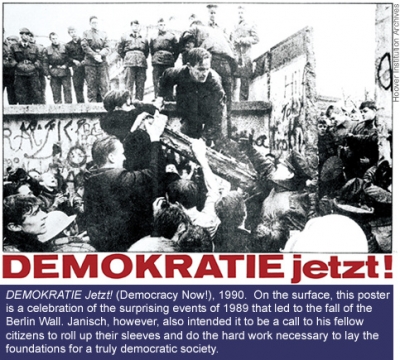
Instead of receiving the brusque reception he had expected, Janisch was warmly greeted by embassy staff, who promised to forward his posters to Moscow. When he asked if the package would actually be sent to Gorbachev, a young embassy employee assured him that “of course we’ll send it to him.” When Janisch checked in with the embassy a few weeks later, officials there assured him that not only had they received a message of heartfelt thanks from Moscow but that a letter to that effect was on its way to Janisch from the cultural attaché.
The story of Janisch’s encounter was soon told in the pages of the leading West German newsmagazine, Der Spiegel, much to the chagrin of the East German government. The irony of his own government’s chilly reception to this gesture, in stark contrast to the official Soviet response, was not lost on Janisch or his colleagues.
This story is one of many fascinating vignettes in the archival collection of Wolfgang Janisch in the Hoover Institution Archives, which was recently featured in the Hoover Exhibit Pavilion in an exhibition titled Revolutionary Eye: The Political Poster Art of Wolfgang Janisch, 1979–1999. Like many of the historic collections in the Hoover Institution Archives, the Janisch collection appears on the surface to be about one topic: the posters that Janisch created to voice his opposition to the dictatorial regime of East Germany during the 1970s and 1980s. Beneath the surface, however, Janisch’s papers and unpublished memoirs also reveal much about German history during the past 60 years. Janisch frequently points out that he has “lived through five forms of government” in his lifetime, which provides a useful lens through which to look at Janisch’s life as well as the forces that have shaped his art and worldview.
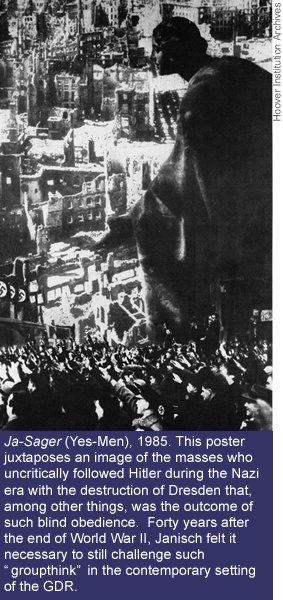
The Nazi Years and World War II
Wolfgang Janisch was born in Berlin in 1940 and raised in the nearby village of Fredersdorf. At the time of his birth, war had been raging in Europe for more than a year, and German civilians were beginning to reap the bitter fruit of Nazi aggression. Janisch’s earliest years were punctuated by nightly bombing raids that would roust his family from bed and send them scurrying to the nearest underground shelter. After one such night of repeated trips to the air-raid shelter, Janisch’s mother gathered the children in the hallway of their home, saying that, if a bomb hit their house, at least they would all die together. Janisch’s father, who worked with the fire brigades in Berlin, would return home each morning smelling of smoke and filled with tales of the horrors he had witnessed the night before. Such experiences deeply imprinted themselves on young Wolfgang—as they did with many Europeans of his generation—and shaped his lifelong opposition to war.
Although it was very dangerous to openly voice criticism of the Nazi regime, Janisch’s mother instilled in her son a healthy skepticism toward authoritarian claims to power, often taking side streets to avoid encountering roving bands of SA troops, to whom she would have had to give the obligatory “Hitler salute.” During the war, Janisch’s parents defied the authorities by tuning their radio to broadcasts from London—an offense that could have landed them in prison. Mrs. Janisch also sought to keep her two sons out of the youth organizations that were precursors of the Hitler Youth.
In later years, when Janisch’s poster art warned of the buildup of nuclear weapons or criticized the arbitrary nature of the East German dictatorship, he often pointed back to his memories of the Nazi years and the disastrous consequences that Europe faced as a result. Just as his generation pointed the finger at his parents’ generation, asking how they could have permitted the Nazis to come to power, so he averred that future generations would point the finger at his own if it did nothing to prevent a nuclear holocaust or to challenge the ossified power structure of East Germany.
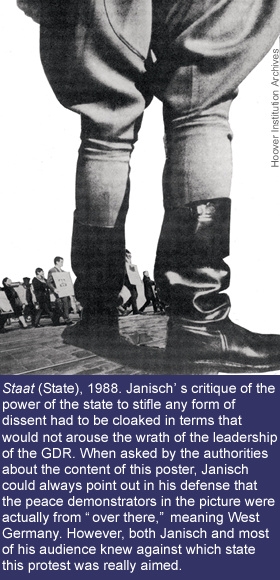
The End of the War and Soviet Occupation
As the war drew to a close in the spring of 1945, a feeling of fear and uncertainty descended on Janisch’s village as Soviet troops advanced on Berlin. At night, the sky to the east glowed red as the approaching Red Army fired steady barrages of artillery westward. By day, streams of retreating soldiers and refugees filled Fredersdorf with frightening stories of rape, looting, and other atrocities committed by the Red Army soldiers in revenge for the immense suffering that the Nazis had inflicted on their homeland. For many who lived through this period, their memories of the last days of the war contain scenes of death and carnage set against the backdrop of blossoming trees and warm spring breezes.
When the Soviets finally reached Fredersdorf, some of these dire predictions were realized, but not to the extent that had been feared. Instead, Janisch’s memoirs depict images that were bizarre and at times even amusing. As Soviet T-34 tanks rumbled through the village, hungry soldiers ripped entire cherry trees out of the ground and fastened them to their tanks so they could pluck fruit from the branches as their tanks rolled on. To billet Soviet soldiers and officers, Janisch’s family was moved into other living quarters, side by side with newly arrived refugee families from the eastern provinces, whose own homelands had been annexed by Poland and the Soviet Union.
In those early post-war years, the occupying Soviet troops were a force to be feared. Yet glimmers of humanity also shone through. On a trip to Berlin by train, Wolfgang and his mother, filled with trepidation, entered a compartment filled with Soviet soldiers. As the soldiers warily eyed them, one soldier asked in broken German what Mrs. Janisch thought of Russians. “Well,” she said, “there are good and bad people in every nation.” The ice broken, they were friendly and respectful of Wolfgang and his mother. Some soldiers stationed in Fredersdorf also befriended the Janisch family, giving the children rides on their backs and conversing with the parents about the current political situation, including their fears of a new war with the Americans and other Western powers.
Much of Janisch’s poster art reflects these mixed encounters with the foreign occupiers. Some posters evoke images of the grimness of Stalinism; others appeal to the common humanity shared between the nations of the Eastern Bloc and the West, which Janisch first experienced during these years.
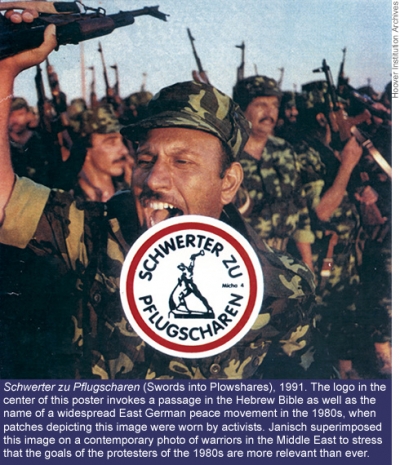
Life in the German Democratic Republic
Of the five forms of government that Janisch has experienced in his life, the one of longest duration by far was that of the German Democratic Republic (GDR), the Soviet satellite state that was established in October 1949. During Janisch’s adolescence, the ways in which the new government ruled seemed to him eerily reminiscent of the Nazi dictatorship. Land was expropriated from farmers; political parties that opposed the ruling Socialist Unity Party (SED) were silenced through terror and arrests or co-opted by the SED; and militaristic activities—such as weapons training—were introduced in schools and youth groups. An economics of scarcity prevailed as well. Everyday consumer goods were in short supply because the state placed a high priority on the rapid development of heavy industry, which would also have dire consequences on the environment in later decades.
Because the border between East and West Berlin was still open, many East Berliners found good jobs in the Western sector or, like the Janischs, made frequent trips there to sell their homegrown produce and earn badly needed extra income. Throughout the 1950s, an increasing number of East Germans also used this porous border to flee to the West.
When Janisch finished secondary school, his artistic interests led him to apprentice as a typesetter, with hopes of working in the design department of a book publisher. Yet, like many other East Germans, his plans were abruptly changed when the Berlin Wall was constructed on August 13, 1961, effectively sealing off all border crossings. A position with a publisher that had been promised to Janisch was withdrawn as this company now found it necessary to hire East Berliners who had formerly commuted to jobs in the West. Despite this setback, Janisch eventually found work in a succession of state-run publishing houses, where he developed his craft while working as a typographer, as well as designing book jackets, covers, and title pages.
The two decades Janisch spent working in these publishing houses gave him a new perspective on the East German state. In book design, political priorities often trumped aesthetic concerns. In a state where citizens were exhorted to conserve and recycle scarce raw materials, Janisch witnessed enormous waste. In one case, the entire print run of a book, which Janisch had designed, was consigned to the shredder when a high-ranking member of the party objected to the use of colors other than red on the cover and title page.
Janisch also became increasingly disillusioned with the SED’s effect on East German society as a whole. When East German troops joined the Soviets in the invasion of Czechoslovakia in 1968 following the ill-fated Prague Spring, Janisch, feeling intimidated, added his signature to an officially sponsored petition that was circulated at his workplace affirming the invasion. But when a similar petition over the forced exile of the popular dissident folk singer Wolf Biermann made the rounds in 1976, Janisch conspicuously refused to sign. In addition to the all-pervasive hypocrisy of the party, whose leaders—at odds with the notion of a “classless society”—lived at a level of luxury and privilege unknown to most East Germans, Janisch was also troubled by two developments during the 1970s and 1980s: the heightened arms race with the West and the massive environmental destruction that resulted from the heavy push toward industrialization.
For many years, Janisch had pursued his artistic interests outside of his work hours, creating woodcuts, pen and ink drawings, and designs for screen prints. These works, created at the kitchen table of the small apartment that he shared with his wife and two daughters, were an escape from the increasingly grim reality of everyday life in the GDR. Soon, however, he began to channel his frustrations and rage into his artwork, resulting in an extensive series of posters sharply criticizing the ruling regime. Inspired by the work of the Dadaist artist John Heartfield, Janisch came to believe that photo-collages would be the most suitable medium for expressing his messages, since he felt that photography was an inherently honest medium. Once embarked on this path, he experienced what he later called an “artistic eruption,” which kept him feverishly working many nights until two in the morning, and then rising to go to work at the publishing house.
In the early 1980s, Janisch began displaying his posters in churches, one of the few places where dissident groups—especially environmental and peace activists—could openly meet in the GDR. In 1983, when his work had begun to be exhibited more widely, and his pacifist convictions created difficulties with his employer, he resigned from the publishing house, taking a “leap into cold water” as a freelance artist and full-time peace activist. During the late 1980s, Janisch’s work reached an international audience when peace groups and churches mounted exhibitions of his work in Holland, Denmark, West Germany, and Austria, not to mention the packet of posters that he sent to Moscow via the embassy in East Berlin.
The Fall of the Wall and Reunification of Germany
After the fall of the Berlin Wall in 1989 and Germany’s reunification, life changed dramatically for many East Germans, including Janisch. During this period, Janisch experienced the fourth and fifth forms of government he has witnessed during his lifetime: the Federal Republic of Germany and the country’s participation in the evolving experiment of the European Union.
For many East Germans, this era initially brought joy and high expectations, as they sampled new freedoms and previously unavailable opportunities. For the first time, they could travel freely to foreign countries, including West Germany, and find consumer goods from those same countries in their neighborhood stores. They could express their opinions without fear, whether in conversations on the street, in newspapers, or in the newly formed citizens groups that sought to shape the political future of this new country. Yet this initial euphoria was soon tempered by the challenges of adapting to a new and alien system. Fifteen years after reunification, this process of change has proven to be much more difficult than anyone had anticipated. As a result many eastern and western Germans now view one another with suspicion and misunderstanding, rather than as long-lost family members.
In this context Janisch has continued to create his posters, which reflect his ambivalence about these developments and ask difficult questions as Germans seek both to overcome their traumatic past and to contribute to a peaceful, stable, and democratic European order.
In viewing Janisch’s posters over the past three decades, one is reminded of the quote of the American theologian Reinhold Niebuhr, who once described the role of the prophet in the Hebrew Bible as someone who “comforted the afflicted and afflicted the comfortable.” In a similar way, Janisch has cast his own prophetic eye on the events of the world around him, responding with posters that urgently cry out for change. As the events of 1989 show, such actions have proven to be more than just “voices crying in the wilderness,” demonstrating that even one person—in the right time and place—can help bring about needed change.








